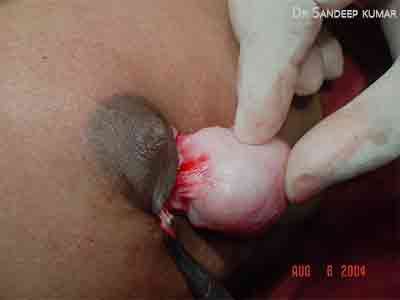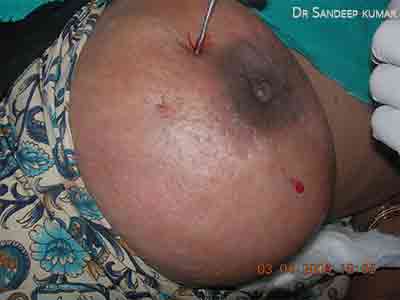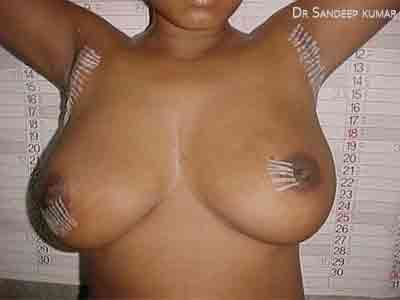Breast pain & nodularity
Aberration of normal breast involution, breast pain or mastalgia : It is the normal breast pain that a women perceives sometimes during , before or after periods. It is indeed a normal finding and a physiological aberration of normal development and involution. This can be treated if it is affecting your daily chores of work otherwise reassurance plays an important role.
It is also called mastalgia or mastodynia. Nodularity or granularity in breasts is a common occurrence and should be regarded as a variation of normal. This condition has been described in literature for the past 10 years as ANDI – Aberration of Normal Development and Involution. Breast nodularity is a physiologic, hormonally mediated change characterized by lumpiness of the breast and varying degrees of pain and tenderness.* (Visual analogue scale for assessing breast nodularity in non discrete lumpy breasts: The Lucknow Cardiff breast nodularity scale. Kumar Sandeep, Rai R, Das V, Dwivedi V, Kumar S, Agrawal GG. The Breast 2010; 19 : 238 – 242) This clinic has described an internationally accepted scale to assess breast pain and nodularity. The assessment of mastalgia requires a careful structured history, detailed physical examination and follow up by a pain chart. The size of breasts, feeling of heaviness and pain and nodularity are often related to menstrual cycle. Breast that become tender to touch before periods are mostly normal. As long as the doctor is satisfied that there is no discrete lump the patients should be simply reassured and reassesses at intervals rather than prescribe investigations. A large number of patients get confused and unnecessary investigations and also unnecessary biopsy for this condition.
If it is mild it can be regarded as normal. If it is troublesome enough to warrant attention it may be regarded as disorder and when it is so severe that it interferes with the quality of life, it can be regarded as a disease.
There are now harmless effective drugs that are not very expensive to treat breast pain and lumpiness. This clinic has a major published trial in an international journal for the treatment of this condition* (A Randomised Double Blind Placebo Controlled Clinical Trial of Centchroman (Ormeloxifene) in Breast Pain and Nodularity (Benign Breast Disorder). Kumar Sandeep, Rai R, Agarwal GG, Dwivedi V, Kumar S, Das V. National Medical Journal of India 2013; 26: 69-74)
Benign Tumors
Any lump formed by body cells may be referred to technically as a tumor. Most breast lumps – 80% of those biopsied – are benign (non-cancerous). Following are examples of the most common benign breast conditions which produce lumps.
Fibrocystic changes: This is not a disease, but rather a benign (not cancer) condition affecting 50 to 60 percent of all women. Fibrous breast tissue, mammary glands, and ducts overreact to the normal hormones produced during ovulation, resulting in the development of fibrous lumps and/or numerous, small multiple cysts, (lumpy, fluid-filled sacs, or “pockets”). Fibrocystic changes are an exaggerated response of breast tissue to changes of ovarian hormones.
Fibrocystic changes are the most common non-cancerous breast condition. They are most common in women between the ages of 20 and 50. They are unusual after menopause unless a woman is taking hormones.
The size and tenderness of Fibrocystic lumps usually increase before menstruation, decreasing after the period ends. This condition, also known as cystic mastitis, generally disappears after menopause. Medical opinion is still divided over whether Fibrocystic disease increases the risk of breast cancer.
Recent research has reported that the chemical called methylxanthines, found in coffee, tea, cola, chocolate and some diet and cold medication, seems to promote the growth of Fibrocystic lumps. In one study, more than half the women who gave up the above items from their diets found that their cysts gradually disappeared.
- Giant / Multiple fibroadenomas : Shape, size and cosmetic related breast problems :

Papillomas: These small wart like lumps grow in the lining of the mammary ducts, near the nipple. The often result in a discharge, either clear or bloody, from the nipple
Breast Mastitis:
Mastitis is an infection of the breast. There are three types: lactational mastitis, chronic subareolar abscess and nonlactational mastitis.
Lactational mastitis / Breast abscess the most common type of mastitis, occurs when a woman is breastfeeding. When a milk duct is blocked by thick milk that doesn’t flow, bacteria is trapped and an infection may develop. Some easy initial ways to relieve the uncomfortable symptoms are massage, warm soaks, heat, and ice packs. If they don’t work, antibiotics usually do. In the rare case where an abscess, or collection of pus, forms, a needle is used to drain the abscess. In even rarer cases where a large abscess forms, surgery to drain the infection may be recommended. Most breast abscess occur during or in the lactational period when women are feeding babies. Frequent washing of breast and nipple with plain water is the best prevention. Fingers should not be put in babies mouth. Frequent hand washing prevents breast abscess.
One common mistake is to drain the breast abscess when the women is feeding. Incision of breast during lactation leads to chronic breast milk leakage called fistula. These days we do not suppress or give medicines to stop lactation. There is no harm to continue to feed the baby while the breast abscess is under treated
We treat breast abscess with utmost tender care. Specific antibiotics, encourage breast feeding, manual expulsion, fermentations, repeated aspirations and vacuum aspiration devices. Some chronic abscess with multiple recurrence are selectively treated using kshar sootra
Nonlactational mastitis may occur under special circumstances in women who aren’t breastfeeding. These include women who have had radiation following a lumpectomy or women whose immune systems are naturally weak or compromised due to such conditions as loss of lymph nodes. Skin boils or staph infections that can develop on other parts of the body as well as on the breast can also lead to nonlactational mastitis.
If you notice any change in your breasts, or suspect you may have an infection, it’s important to be checked by your physician.
SOURCE:
Love, S. M. (with Lindsey, K.). (2005). Dr. Susan Love’s breast book (3rd ed.). Reading, MA: Addison-Wesley.
Chronic subareolar abscess is the second most common breast infection, although it seldom occurs. The cause of this infection is unclear, but milk ducts or tiny glands on the nipple become infected due to blockage. If the infection is caught before an abscess forms, antibiotics may help. If not, surgery may be recommended. This type of infection tends to recur, but does not increase a woman’s risk of developing breast cancer.
Axillary Breast
Nipple discharge – Micrododectomy

































